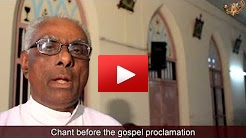
AP 60 to 51
Fr. Jose P Kottaram in conversation with Dr. Joseph J. Palackal.
| Call Number | AP 54 |
| Part Number | Part I - Syro Malabar Church |
| Title | Fr. Jose P Kottaram in conversation with Dr. Joseph J. Palackal. |
| Duration | 40:50 |
| Place of Recording | Chapel of St. John Berchman's Higher Secondary School, Changanacherry, Kerala. |
| Date of Recording | 1 August 2014. |
| Youtube URL | https://www.youtube.com/watch?v=6QisiR-pgNg |
| Video Segment (s) | AP 54a to 54o |
Notes
Fr. Jose P Kottaram in conversation with Dr. Joseph J. Palackal.
NOTE:Fr. Jose Kottaram, who immersed himself in the Syriac tradition of the Syro Malabar Church from his childhood days, gives us requiem versions of melodies for three chants: “Slīwā dahwā lan,” O dez damman,” and “Qadkāyen.” He says that he learned these melodies by listening to requiem Raza that used to be celebrated frequently during those days in his parish. This are examples of singing the same text in two different ways to create different effects in the liturgy. In contrast to singing the same text with two different melodies, Fr. Kottaram also gives several examples of singing the same melody to text in Syriac and its translation in Malayalam. The transference of the melody from text in one language to another seems to take place smoothly. This was an interesting phenomena in the 1960s, during the transition of liturgies from Syriac to Malayalam. The Syriac chants were translated into Malayalam while retaining the melody of the original Syriac text. This helped the continuation of the melodies even when the original chant texts faded from the memories. See a detailed study of the transference of melody from the Syriac text to its Malayalam translation in my chapter, “The Survival Story of the Syriac Chants among the St. Thomas Christians in South India” in the Oxford Handbook of Music and World Christianities
Fr. Kottaram’s chanting of two prayers before the final blessing in solemn Qurbana shows the influence of the melody of the Latin chant Exultet. This melody, which was introduced by the Portuguese missionaries in the sixteenth century, seems to have been popular among the Syriac singers (see other examples in 25K and 25L). Fortunately, Fr. Kottaram is able to recall, albeit after about fifty years of disuse, the chanting style of the Passion narrative on Good Friday. The melodic formula seems to be the same as that of the Veneration of the Cross that we heard in Aramaic Project-Part 4 ........ Joseph J. Palackal
01. About learning Syriac during Priestly formation (0:44)
02. Melody of “Suwha lawa” (5:15)
03. Requiem melody of “Slīwā dahwā lan.” From Raza for the dead (5:50)
04. Malayalam version of the requiem tune of “Slīwā dahwā lan.” (7:38)
05. Two melodies of “Odez damman’ Before reading from the epistle (8:15)
06. Chant before the gospel proclamation (9:02)
07. “Thaibuthe d’maran iso misiha” Salutation and dialogue between the celbrant and congregation during anaphora. Syriac and Malayalam versions (9:26)
08. Melody of “Qadkayen” (14:45)
09. Style of chanting the slotha before Huthamma on Sundays (15:13)
10. Chanting of the blessing before communion: Syriac and Malayalam versions (19:30)
11. Melody of “Ualappai’ (20:00)
12. Chanting of the Institution Narrative (20:35)
13. The musical scene at St. Joseph’s Seminary at Mangalappuzha (23:48)
14. Style of chanting the Scripture readings (23:45)
15. Melody of the introduction to the proclamation of the Gospel (25:45)
16. Melody of “Rahme suqana” Rite of reconciliation (29:08)
17. Chanting of the Passion Narrative on Good Friday (30:10)
18. Pope Leo XIII and St. Berchman's Higher Secondary School (31:29)
19. About Fr. Abel Periyappuram CMI (38:18)
Video Segments
- AP 54a - Fr. Jose P. Kottaram. Melody of “Šuwha lawā.” Commemoration hymn.
- AP 54b - Fr. Jose P. Kottaram sings the requiem melody of “Slīwâ dahwâ lan” from Raza for the dead.
- AP 54c - Fr. Jose P. Kottaram sings the Malayalam version of the requiem tune "Slīwâ dahwâ lan" Ōnītâ d’kanke .
- AP 54d - Fr. Jose P. Kottaram sings two melodies of "Odez damman" from Raza. This is sung before reading from the Eipistle.
- AP 54e - Fr. Jose P. Kottaram sings "odem haymnīn". Before the proclamation of the Gospel in solemn Raza.
- AP 54f - Fr. Jose P. Kottaram sings "Thaibūthe d’māran īšōmišīhâ."
- AP 54g - Fr. Jose P. Kottaram sings two melodies of “Kad qāyēn” - the introduction to "Holy, Holy Holy" in solemn Qurbana in Syriac.
- AP 54h - Fr. Jose P. Kottaram sings "Yāēmār b’kōl yāwmīn" which is the slotha (prayer) before the Huthamma (final blessing) on Sundays in Qurbana in Syriac..
- AP 54i - Fr. Jose P. Kottaram sings "Māwhawthâ d’thaibūthē. Blessing before communion.
- AP 54j - Fr. Jose P. Kottaram sings "Ual appai".
- AP 54k - Fr. Jose P. Kottaram chants the Institution narrative in Syriac.
- AP 54l - Fr. Jose P. Kottaram. Chanting of sacred scripture in Syriac.
- AP 54m - Fr. Jose P. Kottaram sings the Exchange of peace and the introduction to the Gospel.
- AP 54n - Fr. Jose P. Kottaram. Melody of “Rahme šūqānâ” (the reconciliation rite).
- AP 54o - Fr. Jose P. Kottaram. Chanting of the Passion narrative on Good Friday.



